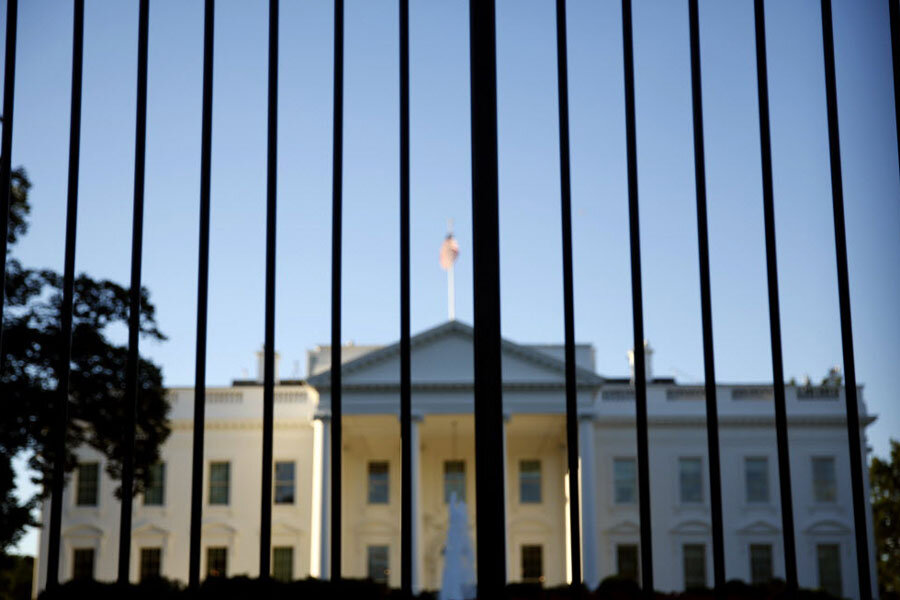Will White House become fortress after Omar Gonzalez intrusion?
Loading...
| Washington
The US Secret Service may propose enlarging the security buffer zone around the White House to defend against fence-jumpers entering the Executive Mansion complex.
Consideration of such a move comes after Omar Gonzalez, a military veteran who carried a small knife in his pocket, climbed the barrier on Friday night and made it inside the unlocked White House door before agents subdued him.
President Obama and the first family were never in danger, as they had left the White House minutes before. Mr. Gonzalez was not injured during the incident.
Fence-jumping can end in tragedy: In 1976, a local taxi driver named Chester Plummer scaled the White House fence carrying a 3-foot length of metal pipe. He ignored repeated orders to halt and was fatally shot before he reached the White House itself.
Now Friday’s widely publicized breach of security is causing executive branch officials who deal with White House security to consider keeping pedestrians off the sidewalks surrounding the grounds in order to gain an extra measure of protection. Another proposal would erect some sort of barrier to screen people a block or so from White House entrance gates, according to the Washington Post.
“Although last night the officers showed tremendous restraint and discipline in dealing with this subject, the location of Gonzalez’s arrest is not acceptable,” said a Secret Service statement issued Saturday afternoon.
If the proposal is adopted, it would be in keeping with the history of White House security. At first a people’s house which allowed the public free access, over the centuries the Executive Mansion has become a virtual fortress, step-by-step.
Security is tightened at intervals in response to particular incidents.
Thus in 1835, after a gunman tried to shoot President Andrew Jackson at the Capitol, a wooden “watch box” for a sentry was built on White House grounds, according to a 1995 public report on White House security. This was perhaps the first exterior guard house ever built on the complex.
US troops guarded the White House during the Civil War. But security diminished afterward, until an increase in threats directed against President Grover Cleveland in the 1890s prompted him to increase the number of policeman serving at the mansion from three to 27. The Treasury’s Secret Service, founded in 1865 to fight counterfeiters, provided a few agents as an inner ring of presidential protection.
Modern White House security really began with the advent of World War II. The White House police force was expanded to 140. Sentry boxes were built on both sides of a fence around the White House grounds.
“No one was allowed in the White House without an appointment. You could no longer walk up to the front door and ask to see the president. There would be no more strolling on the lawn on a pretty spring day,” according to a description of the change posted on the White House Historical Association website.
Since then the physical presence at the mansion’s perimeter has only expanded.
In the 1980s, the terrorist assaults on the Marine barracks and US Embassy in Beirut, Lebanon, caused White House officials to erect barriers meant to protect the White House against vehicle bombs. Concrete jersey barriers came first; eventually, they were replaced by the sturdy bollards that surround the building today.
Vehicular traffic around the White House gradually has been restricted. First, cars were banned from both East and West Executive Avenues, along the mansion’s sides.
Then in 1995, President Clinton ordered Pennsylvania Avenue itself shut in the wake of the destruction of the federal building in Oklahoma City. This was not popular with many city residents, as the street was a six-lane boulevard that carried some 26,000 vehicles a day.
The Washington Post editorialized against the closing. Some members of Congress denounced the move in floor speeches.
But the pedestrian mall established by the changes quickly grew popular. The increasing threat of radical Islamist terrorism muted objections. D.C. residents and workers grew used to a more security-conscious guard force around the complex.
Now it appears this presence may be tightened once more. Perhaps even Lafayette Square, the people’s park across Pennsylvania Avenue, long used by protesters and office workers eating lunch, will become a more restricted space.
However, the new security ideas remain notional, according to news reports, and it is likely there will be lots of debate before things change. A number of agencies, including the National Park Service, get to comment on White House protection.








